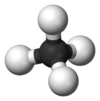Yttrium hydride
Topic: Chemistry
 From HandWiki - Reading time: 4 min
From HandWiki - Reading time: 4 min
| Identifiers | |
|---|---|
| ChemSpider |
|
| EC Number |
|
PubChem CID
|
|
Except where otherwise noted, data are given for materials in their standard state (at 25 °C [77 °F], 100 kPa). | |
| Infobox references | |
Yttrium hydride is a compound of hydrogen and yttrium. It is considered to be a part of the class of rare-earth metal hydrides. It exists in several forms, the most common being a metallic compound with formula YH2. YH2 has a face-centred cubic structure, and is a metallic compound. Under great pressure, extra hydrogen can combine to yield an insulator with a hexagonal structure, with a formula close to YH3.[1] Hexagonal YH3 has a band gap of 2.6 eV. Under pressure of 12 GPa YH3 transforms to an intermediate state, and when the pressure increases to 22 GPa another metallic face-centred cubic phase is formed.[2]
In 1996, it was shown that the metal-insulator transition when going from YH2 to YH3 can be used to change the optical state of windows from non-transparent to transparent.[3] This report spurred a wave of research on metal hydride-based chromogenic materials and smart windows; gasochromic windows reacting to hydrogen gas and electrochromic structures where the transparency can be regulated by applying an external voltage.[4] When containing a substantial amount of oxygen, yttrium hydride is also found to exhibit reversible photochromic properties.[5] This switchable optical property enables their utilization in many technological applications, such as sensors, goggles, and medical devices in addition to the smart windows. According to a research results, the strength of the photochromic response is found to decrease with increasing oxygen concentration in the film accompanied by an optical band gap widening. [6]
Yttrium hydride is being looked at as a high temperature superconductor.[7]
Yttrium hydride is being looked at as a neutron moderator[8] for use in new nuclear reactor designs.
References
- ↑ Kume, Tetsuji; Ohura, Hiroyuki; Takeichi, Tomoo; Ohmura, Ayako; Machida, Akihiko; Watanuki, Tetsu; Aoki, Katsutoshi; Sasaki, Shigeo et al. (31 August 2011). "High-pressure study of ScH3: Raman, infrared, and visible absorption spectroscopy". Physical Review B 84 (6): 064132. doi:10.1103/PhysRevB.84.064132. Bibcode: 2011PhRvB..84f4132K.
- ↑ Machida, Akihiko (2007). "Unique Structures in Yttrium Trihydride at High Pressure". Research Frontiers. SPring 8. pp. 58–59. http://www.spring8.or.jp/pdf/en/res_fro/07/058-059.pdf.
- ↑ Huiberts, J. N.; Griessen, R.; Rector, J. H.; Wijngaarden, R. J.; Dekker, J. P.; de Groot, Koeman; N J (1996). "Yttrium and lanthanum hydride films with switchable optical properties". Nature 380 (6571): 231. doi:10.1038/380231a0. Bibcode: 1996Natur.380..231H.
- ↑ van der Sluis, P.; Mercier, V. M. M. (2001). "Solid state Gd-Mg electrochromic devices with ZrO2Hx electrolyte". Electrochimica Acta 46 (13–14): 2167. doi:10.1016/S0013-4686(01)00375-9.
- ↑ Mongstad, T; Plazer-Björkman, C.; Maehlen, J. P.; Mooij, L.; Pivak, Y.; Dam, B.; Marstein, E.; Hauback, B. et al. (2011). "A new thin film photochromic material: Oxygen-containing yttrium hydride". Solar Energy Materials and Solar Cells 95 (12): 3596. doi:10.1016/j.solmat.2011.08.018. Bibcode: 2011arXiv1109.2872M.
- ↑ Moldarev, Dmitrii; Moro, Marcos V.; You, Chang C.; Baba, Elbruz M.; Karazhanov, Smagul Zh.; Wolff, Max; Primetzhofer, Daniel (2018-11-26). "Yttrium oxyhydrides for photochromic applications: Correlating composition and optical response". Physical Review Materials 2 (11): 115203. doi:10.1103/PhysRevMaterials.2.115203. Bibcode: 2018PhRvM...2k5203M. https://link.aps.org/doi/10.1103/PhysRevMaterials.2.115203.
- ↑ "Scientists Synthesize New High-Temperature Superconductor" (in en-US). 2021-03-12. https://interestingengineering.com/scientists-synthesize-new-high-temperature-superconductor.
- ↑ "ORNL developing 3D-printed nuclear microreactor : New Nuclear - World Nuclear News". https://www.world-nuclear-news.org/Articles/ORNL-developing-3D-printed-nuclear-microreactor.
 |
 KSF
KSF






